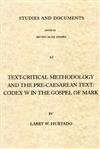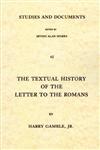New Testament Textual Studies and Documents Series (3 vols.)
Digital Logos Edition
Overview
These three volumes represent some of the important text-critical research of the twentieth century. Covering a variety of topics from methodology in determining the value of miniscule manuscripts and determining textual relationships to the textual history of a Pauline epistle, these three volumes are important and essential reading to all those interested in textual criticism, whether student, scholar, or informed layperson.
Founded by Kirsopp and Silva Lake, Studies and Documents is a monograph series devoted to basic research in the manuscript tradition of the New Testament. It promotes the publication of primary sources and critical studies that advance the understanding of the history and transmission of the text of the New Testament. Chiefly concerned with paleography, codicology, and textual criticism, the series seeks to illumine the way in which Western culture has preserved and appropriated a major element of its literary legacy.
With Logos Bible Software, these three valuable volumes becomes more accessible than ever, especially when used alongside Comfort and Barrett's The Text of the Earliest New Testament Greek Manuscripts, Metzger's Textual Commentary on the Greek New Testament, or any number of technical commentaries.

Key Features
- An important reevaluation of the Byzantine minuscule manuscripts and their potential significance
- A critique and survey of the methodology involved in determining manuscript family and a proposed way forward
- A strong defense of the literary unity and integrity of Paul's Letter to the Romans
Praise for the Print Edition
We are thankful that such a careful and revealing study as this is being done on the minuscules. Wisse’s work is properly giving these minuscules some deserved attention, along with the early papyri and uncials.
—D. P. Kuske, Wisconsin Lutheran Quarterly, 1983
Hurtado is always cautious not to advance beyond his information, clearly distinguishing between factual conclusions and theoretical observations. . . . [His] work is a welcome addition to this important series.
—Carroll D. Osburn, Journal of Biblical Literature, 1983
This is the first monograph-length study of the ending of the Roman letter and is “must” reading for scholars studying or teaching the epistle.
—Larry W. Hurtado, Journal of the Evangelical Theological Society, 1978
Product Details
- Title: New Testament Textual Studies and Documents Series (3 vols.)
- Series: Studies and Documents
- Publisher: Eerdmans
- Volumes: 3
- Pages: 413
Individual Titles

The great number of New Testament manuscripts makes that task of citing evidence in text-critical studies appear to be overwhelming. Since it is not practical to cite all of the manuscript evidence, scholars have attempted to find representative texts. Long ago they noted that many of the manuscripts were related, i.e., certain groups of manuscripts share certain combinations of variants, probably because members of the groups are “descendants” of the same manuscripts. The profile method is Professor Frederik Wisse's attempt to establish “an accurate and rapid procedure for the classification of the manuscript evidence of any ancient text with large manuscript attestation, and to present an adequate basis for the selection of balanced representatives of the whole tradition.”
Wisse begins with a discussion of the role in New Testament text criticism of the manuscripts written in cursive script, the minuscules. Because of their late date and large number, minuscules are often given secondary consideration, but Wisse contends that they “can and should figure prominently” in text criticism. He then examines previous attempts to classify New Testament manuscripts, including the work of H. F. von Soden, K. Aland, and E. C. Colwell. The weaknesses of these attempts demonstrate the need for a better method. Wisse next outlines how he arrived at the profile method. While working on the International Greek New Testament Project he realized the need for a method that could both rapidly test all known groups and spot their most representative members and also be an objective standard for evaluating the text of the many minuscules that did not fit into known groups. The Project had collated all the manuscript evidence on Luke and for Luke 1 had all the existing variants, even the most minute, typed out with supporting manuscript evidence. It became clear that the essential ingredients for group definition are all the variants in a passage that have the support of one or more groups.
Using tentative group definitions (from suggestions by earlier scholars), Wisse made a selection of test probability of showing group affiliation. The manuscripts can be profiled by noting their agreements with the chosen variants against the Textus Receptus. The qualifications for a group are a large degree of internal agreement among members and a group profile that differs significantly from profiles of other proposed groups. In order to insure a fair sample, Wisse examined three chapters from Luke (1, 10, and 20). The results of his sampling are given in comprehensive lists and charts that classify the manuscripts of Luke and show the groups and clusters. He concludes by showing briefly how the profile method can be used with other texts that have a large manuscript attestation.
Frederik Wisse is Associate Professor of New Testament at McGill University, Montreal, Canada.

Text-Critical Methodology and the Pre-Caesarean Text: Codex W in the Gospel of Mark is a detailed examination of the textual characteristics and relationships of important early Greek manuscripts of the Gospel of Mark (chiefly Codex Washingtonianus [W], and also Family 13 and P45), and challenges the generally-accepted view that these manuscripts are witnesses to an early stage of the Caesarean text-type.
The study begins with a discussion and critique of previous studies on the Caesarean text-type, showing the methodological weaknesses that demand a fresh analysis of the data and emphasizing the crucial importance of Codex W for the whole question of the textual history of Mark. Then a methodological approach is set forth, involving both careful quantitative measurement of manuscript agreements and detailed analysis of variants in the interest of determining both the textual relationships and textual character of manuscripts.
When this more sophisticated approach is applied to the chief witnesses to the so-called “pre-Caesarean” text of Mark, it is confirmed that W and P45 is a weaker member of the same group. However, the commonly-held view that these witnesses reflect the early stage of the Caesarean text-type is shown to be erroneous. In addition to clarifying the textual relationships of the witnesses, the study defines more accurately their textual character, showing the scribal purposes reflected in the variants that characterize these manuscripts and adding considerably to our knowledge of the forces affecting the early transmission of the text of Mark.
This is the first detailed examination of the Markan text of Codex W since the publication of the manuscript over 65 years ago, and the first published book-length study dealing with the Caesarean text of Mark since the initial work of Kirsopp Lake and his colleagues Blake and New. This work not only addresses a major issue in the textual history of Mark, but offers methodological suggestions for the continuing investigation of the textual history of the New Testament.
Larry W. Hurtado is professor of New Testament language, literature, and theology at the University of Edinburgh, Scotland.

This monograph is a defense of the literary unity of the book of Romans, a subject that has been treated in terms of textual criticism or of literary criticism, but not, until now, comprehensively with respect to both fields of research. A long-standing critical question is whether the letter to the Romans originally contained only the material now known as chapters 1–14 or perhaps 1–15. The various placements of a doxology (after 14:23, after 16:23, etc.) and the manuscript evidence for several shorter forms of the letter have raised questions of a text-critical nature. Literary criticism has detected in the content of chapter 16 evidence that it was composed separately, and perhaps even addressed originally to a different church.
Gamble's study first presents the textual witnesses to the various forms of the letter and then examines critically the predominant (“Ephesian”) hypothesis for explaining the evidence. The author brings new evidence into the discussion from the developing field of ancient epistolography, showing how the concluding elements of Hellenistic letters have equivalents in Paul's letters. After characterizing the Pauline equivalents, he applies the findings to the problem of Romans 16, demonstrating that epistolary considerations support the originality of chapter 16 as part of the letter to the Romans. This is corroborated by a critical discussion of the possible origins for the shorter forms of the letter in the early church. The conclusion summarizes the results and their meaning for the textual history of the letter, and sets forth their implications for the interpretation of Romans and for other aspects of the study of the Pauline corpus, especially for theories of partition in relation to other Pauline epistles.
Harry Gamble Jr. is Associate Professor, Department of Religious Studies, University of Virginia, Charlottesville.